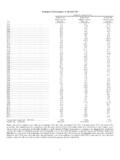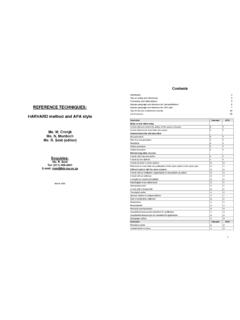Transcription of Conductance Data For Commonly Used Chemicals - Emerson
1 Conductance Data For CommonlyUsed Chemicals44-6039/rev. BDecember 20101 Conductance DATA FOR Commonly used CHEMICALSFrom an analytical point of view, little can be done witha Conductance reading, however accurate it may be,unless it can be related to chemical concentration via atable or graph. Much data has been generated in thepast 100 years in this area, but a comprehensive gath-ering of the information in a form useful to industry hasbeen lacking1. It is hoped that the following will providea ready and reasonably accurate reference of conduc-tance values for the majority of electrolytes encoun-tered in industrial information is presented in graphical form to per-mit rapid evaluation of response patterns and to elimi-nate the time consuming and often impractical(because of non-linearity) extrapolation required intables with widely separated concentrations. Thismethod of presentation sacrifices the precision gainedby listing actual values, but the accuracy retained ismore than sufficient for the great majority of industrialuses.
2 The intent has been to provide a useful workingtool more so than a scientific of the data presented is the result of extremelycareful and accurate laboratory work conducted byvarious researchers over the years. It is recognizedthat older sources of information, notably the extensiveInternational Critical Tables, have been found to beslightly inaccurate due to changes in the definition ofbasic units in recent times as well as to erroneousalignment procedures and measurement , with the previously stated area of applicationin mind, these minor errors are of little significance andmay safely be few curves are based on more casual field condi-tion observations, and others are derived from datawith a low degree of resolution in the original refer-ence. Both will be marked with a single asterisk (*) inthe index that Conductance values have been referenced to a sin-gle temperature of 25 C for convenience (isothermalplots are given for selected Chemicals of major impor-tance).
3 Much of the original data was presented at thistemperature, and all sources fell in the range of 15 to25 C. Where possible, the temperature correction fac-tor was calculated from isothermal equivalent conduc-tances listed in the International Critical Tables. Anaverage was taken over as wide a range as possiblefrom .5N to 5N and 0-25 C. When such a calculationwas not possible, the widely accepted average of2%/ C was used . Temperature factors, of course, willvary in a non-linear manner with respect to both tem-perature and concentration for many Chemicals , but thesmall size of the adjustments render this of little impor-tance. As the majority of corrections involved differen-tials of only 5 or 7 C, errors introduced from thissource will be small. With this in mind, the final effect oftemperature correction error deserves further relative Conductance values at various concentra-tions would not be noticeably affected. The error couldbe approximately but correctly described as relating tothe reference temperature rather than much or too little correction simply means that thecurve shown is really that seen at 24 or 26 ratherthan the indicated 25.
4 It is not anticipated that errorswill exceed the +1 examples given in any except themost unusual guarantees of accuracy can be given, but most ofthe data should easily fall within 5% of the correctabsolute value. The choice of curve shape throughdata points will be a factor in some cases, and it is forthis reason that the points were clearly indicated.(Some were omitted in the lower portions of the scalefor the sake of clarity.)1An earlier and excellent series of curves was published for this purpose by Industrial Instruments Inc. It providedvery detailed data for a half-dozen or so Commonly used Chemicals , and has been included in the list of :1. Concentration is expressed as % by Weight of the anhydrous Conductance units are Plotted data points are indicated by OF Conductance DATA1. International Critical Tables, Vol. Vl, pp. 230-258; McGraw Hill, Handbook of Chemistry and Physics, 55th Edition: CRC Press, Lange s Handbook of Chemistry, 10th and 11 th Graphs published by Industrial Instruments, Inc.
5 ; Cedar Grove, Previously unpublished laboratory measurements performed at Uniloc, Inc., Irvine, Calif. Miscellaneous information regarding single electrolytes obtained from various reliable industrial Electrolyte Solutions, Robinson and Stokes: Butterworths, Electrochemical Data, Dobos: Elsevier, Electrolytic Conductance and the Conductances of the Halogen Acids in Water, Hamer and DeWane: NationalBureau of Standards Publication NSRDS-NBS 33, of Electrochemical Constants, Parsons: Butterworths/Academic Press, OF ELECTROLYTESM aximum Conductance andChemicalpoint of inflection at 25 C Mol. [ mhos/cm/% by wt.](Anhydrous) Acetic acidCH3 COOH1,850/17% Aluminum chlorideAlCl3 *Ammonia/Ammonium HydroxideNH3/NH4OH1,200 *Ammonium bifluorideNH4F HF Ammonium chlorideNH4Cl Ammonium fluorideNH4F Ammonium iodideNH4I Ammonium nitrateNH4NO3 Ammonium sulfate(NH4)2SO4 Ammonium thiocyanateNH4 SCN Barium chlorideBaCl2 *Barium hydroxideBa(OH)2 *Barium nitrateBa(NO3)2 Cadmium bromideCdBr230,000/32% Cadmium chlorideCdCl235,000/22% Cadmium Cadmium nitrateCd(NO3)2108,000/32% Cadmium sulfateCdSO451,000/27% Calcium chlorideCaCl2204,000/24% Calcium nitrateCa(NO3)2122,000/25% Cesium chlorideCsCl Chromic acidCrO3670,000/35% Citric acid(COOH)CH2C(OH)(COOH) H2O7,900/20% (Hyd.)
6 224. Cobaltous Chloride COCl2 Cupric chlorideCuCl2108,000/23% Cupric nitrateCu(NO3)2134,000/28% Cupric sulfateCuSO4 (Ethylenediamine) Tetraacetic acid disodium salt, EDTA sodiumNa2C10H14O8N2 2H2O (Hyd.)329. Ferric chlorideFeCl396,000/16% Ferrous sulfateFeSO453,000/24% Formic acidHCOOH11,500/30% Hydrobromic acidHBr Hydrochloric acidHCl850,000/19% Hydrofluoric acidHF Hydroiodic acidHI Iodic acidHlO3 Lactic acidCH3 CHOH COOH5,700/15% Lanthanum nitrateLa(NO3)397,000/28% Lead (plumbous) nitratePb(NO3)2 Lithium chlorideLiCl190,000/21% Lithium hydroxideLiOH380,000/11% Lithium iodideLiI Lithium sulfateLi2SO483,000/18% Magnesium chlorideMgCl2160,000/18% Magnesium nitrateMg(NO3)2 Magnesium sulfateMgSO458,000/17% Manganous chlorideMnCl2130,000/20% Manganous sulfateMnSO451,500/22% Nickel sulfateNiSO4 Nitric acidHNO3865,000/29% Oxalic acidHO2 CCO2H Phosphoric acidH3PO4230,000/50% Potassium acetateKCH3CO2150,000/32% Potassium bicarbonateKHCO3 biphthalateKHC8H4O4 OF ELECTROLYTES (Continued)Maximum Conductance andChemicalpoint of inflection at 25 C Mol.
7 [ mhos/cm/% by wt.](Anhydrous) Potassium bromideKBr Potassium carbonateK2CO3258,000/34% Potassium chlorideKCl Potassium chromateK2 CrO4 Potassium cyanideKCN Potassium dichromateK2Cr2O7 Potassium ferricyanideK3Fe(CN)6 Potassium ferrocyanideK4Fe(CN)6 Potassium fluorideKF288,000/34% Potassium hydroxideKOH625,000/26% Potassium iodideKl Potassium nitrateKNO3 Potassium oxalateK2C2O4 Potassium permanganateKMnO4 Potassium phosphate (monobasic)KH2PO4 Potassium phosphate (dibasic)K2 HPO4 Potassium sulfateK2SO4 Potassium sulfideK2S535,000/30% Potassium thiocyanateKSCN Procaine hydrochlorideC6H4[COOCH2CH2N(C2H5)2] (NH2) HCI-1,434,000/32% Sea water 477. *Silver fluorideAgF Silver nitrateAgNO3 Sodium acetateNaCH3CO278,000/22% Sodium bicarbonateNaHCO3 Sodium bromideNaBr Sodium carbonateNa2CO3103,000/19% Sodium chlorideNaCl Sodium citrateNa3C6H5O764,500/23% Sodium diatrizoate (Hypaque)Na(CH3 CONH)2C6l3CO218,500/40% Sodium dichromateNa2Cr2O7165,000/40% Sodium ferrocyanideNa4Fe(CN)6 Sodium hydroxideNaOH410,000/15% Sodium molybdateNa2 MoO4 Sodium nitrateNaNO3 Sodium phosphate (monobasic)NaH2PO460,000/28% Sodium phosphate (dibasic)Na2 HPO4 Sodium phosphate (tribasic)Na3PO4 Sodium sulfateNa2SO4 Sodium sulfideNa2S262,000/15% Sodium tartrateNaOOC(CHOH)2 COONa 68,500/24% Sodium thiocyanateNaSCN206,000/34% Sodium thiosulfateNa2S2O3152,000/29% Sodium tungstateNa2WO4 Strontium chlorideSrCl2198,000/30% Strontium nitrateSr(NO3)2113,000/30% Sulfuric acidH2SO4825,000/30% Tartaric acidHO2C(CHOH)
8 2CO2H11,800/24% Tetracaine hydrochlorideCl5H24N2O2 HCI Trichloracetic acidCCl3 COOH Zinc chlorideZnCl2104,000/27% Zinc SulfateZnSO456,500/4% Conductance OF SATURATED SOLUTIONS OF SLIGHTLY SOLUBLEELECTROLYTES (SALTS ARE CORRECTED FOR Conductance OF WATER)(Data from International Critical Tables, Vol. VI) (CN) (CN) (CN)CO2CH(CH3) ,975 AgOH24 , , ? (avg.) (Fluorite) 2H2O25 02,210 CdC2O4 (IO3)3 (C2O4)3 (C4H4O6)3 (?)La(IO3)3 (C2O4)3 (C4H4O6)3 (OH) (C2O4)3 ,692Pb(BrO3) , , (lO3) (PO4) (SCN) , (C2O4)3 (C2O4) , , , , (C2O4) (C2O4)3 C SOLUTION MHOS/CMSUBSTANCETEMP. C SOLUTION MHOS/CM20 ELECTRICAL Conductance OF VARIOUS PURE LIQUIDS(Data from Lange's Handbook of Chemistry, 12th edition)LIQUIDTEMP. C MHOS/CM LIQUIDTEMP. C <43 ACETIC (?)ALLYL .076 BENZOIC BENZOATE25<.001 BENZYLAMINE25<. x 10 7 BROMOBENZENE25<.00002 BROMOFORM25<. DISULFIDE1 x 10 12 CARBON TETRACHLORIDE184 x 10 12 CHLORINE-70 <1 x 10 10 CHLOROACETIC <.
9 <.007 CYMENE25<.02 DICHLOROACETIC ACETATE25< .001 ETHYL BENZOATE25<.001 ETHYL BROMIDE25< .02 ETHYL ETHER25< 4x10 7 ETHYL BROMIDE19<.0002 ETHYLENE CHLORIDE25<. ,800mhosGERMANIUM <1x10 7 HEXANE18<1x10 12 HYDROGEN Conductance OF VARIOUS PURE LIQUIDS(Data from Lange's Handbook of Chemistry, 12th edition)LIQUIDTEMP. C MHOS/CM LIQUIDTEMP. C MHOS/CMKEROSENE25<. <.017 MERCURY010, IODIDE25<.02 METHYL <.017o- or m- NlTROTOLUENE25 <.2 OLEIC ACID15<. <.0002 PETROLEUM 3 x 10 7 PHENETOLE25<.017 PHENOL25<.017 PHENYL OXYCHLORIDE <.0002 PIPERIDENE25< . ACID25<.001 PROPIONITRILE25< .1n-PROPYL BROMIDE25< . ACID80< 4x10 7 SULFONYL CHLORIDE252 SULFUR1151x10 6 SULFUR1305x10 ACID2510000 SULFURYL < 1x10 8o-TOLUIDINE25< .00022 TURPENTINE 2 x 10 7iso-VALERlC ACID80 <4 x 10 x 10 1122 SUMMARY OF FORMULAE,CONVERSION DATA AND MISCELLANEOUS INFORMATION1. To obtain the Conductance at temperatures otherthan reference when the temperature coefficient isknown:CT= CR[1 + tc (T TR)] for the general CR[1 + tc (T 25)] for 25 C = temperature of TR= reference temperatureinteresttc = temperatureCT= conductivity at tem-coefficientperature of interestCR= conductivity at C25= conductivity at 25 C reference2.
10 To obtain the Conductance at 25 C when conduc-tance values at two other temperatures areknown:C25= [CT2(T1 25) CT1(T2 25)]/(T1 T2)3. To obtain the temperature coefficent, referencedto 25 C, when the Conductance at any two tem-peratures is known:tc = (CT1 CT2)/[CT2(T1 25) CT1(T2 25)]4. Centigrade - Fahrenheit conversion: C = 5/9( F 32) F = 9/5( C) + 32A rule-of-thumb method for making the conversion is torecall the easily remembered values at freezing andboiling, and that a change of 5 C is matched by achange of 9 F. Thus, 35 C is seven increments above freezing. Multiply the seven by the Fahrenheit increments of 9 to obtain a Fahrenheit reading that is63 degrees above freezing, or 95 Concentration conversions:Multiply the original concentration value by theconversion factor Resistance values to simulate contacting (elec-trode) sensor:Resistance(ohms) = Cell Constant x 106_____ mhos of solution at 25 C7.















